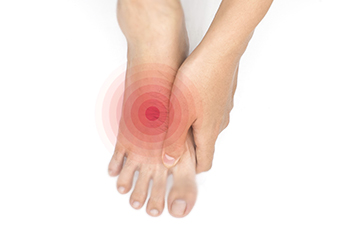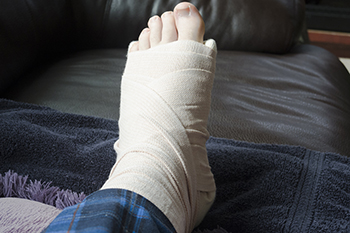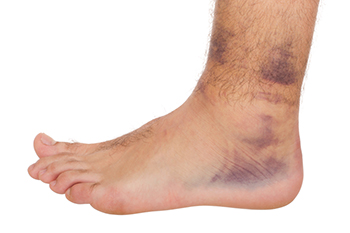Items filtered by date: January 2024
Everyday Foot Care for Diabetic Patients

Proper foot care is essential for anyone with diabetes, as the condition can compromise blood flow and damage nerves. Following these essential steps for diabetic foot care can help a diabetic patient prevent other serious health issues. Start by washing your feet daily with warm water and mild soap, ensuring thorough drying and the application of lotion, excluding the spaces between toes to prevent infections. A daily visual inspection is extremely important to identify potential problems early, given the reduced sensation and circulation associated with diabetes. Trim toenails straight across to prevent ingrown nails, taking special care to avoid cutting cuticles. Choose comfortable footwear, steering clear of high heels and pointy toes, and consider custom orthotics for added support. Protect your feet from injuries by avoiding walking barefoot, wearing quality socks, and refraining from using sharp tools for corn and callus removal. Additionally, manage blood sugar levels and quit smoking to reduce the risk of complications. Many people with diabetes also suffer from neuropathy and peripheral artery disease, which can result in foot ulcers. For this reason, it is suggested that you schedule regular visits with a podiatrist who is medically trained to manage the side effects of this disease.
Diabetic foot care is important in preventing foot ailments such as ulcers. If you are suffering from diabetes or have any other concerns about your feet, contact one of our podiatrists from Ultimate Foot Care . Our doctors can provide the care you need to keep you pain-free and on your feet.
Diabetic Foot Care
Diabetes affects millions of people every year. The condition can damage blood vessels in many parts of the body, especially the feet. Because of this, taking care of your feet is essential if you have diabetes, and having a podiatrist help monitor your foot health is highly recommended.
The Importance of Caring for Your Feet
- Routinely inspect your feet for bruises or sores.
- Wear socks that fit your feet comfortably.
- Wear comfortable shoes that provide adequate support.
Patients with diabetes should have their doctor monitor their blood levels, as blood sugar levels play such a huge role in diabetic care. Monitoring these levels on a regular basis is highly advised.
It is always best to inform your healthcare professional of any concerns you may have regarding your feet, especially for diabetic patients. Early treatment and routine foot examinations are keys to maintaining proper health, especially because severe complications can arise if proper treatment is not applied.
If you have any questions please feel free to contact our office located in Smithtown, NY . We offer the newest diagnostic and treatment technologies for all your foot and ankle needs.
Do You Suffer From Painful Feet?
Diagnosing and Managing Foot Fractures

Foot fractures are common injuries that podiatrists frequently encounter, often involving the metatarsals and toes. Patients typically exhibit various symptoms, with pain and difficulty while walking being the most prevalent. Diagnosis relies on radiographic assessment or ultrasonography. The choice of management depends on the fracture's location and its impact on balance and weight-bearing. Treatment options may include splinting, avoiding weight-bearing activities, casts, boots, or orthotics. If you have sustained a foot fracture of any type, it is suggested that you schedule an appointment with a podiatrist for a proper evaluation and relief options
A broken foot requires immediate medical attention and treatment. If you need your feet checked, contact one of our podiatrists from Ultimate Foot Care . Our doctors can provide the care you need to keep you pain-free and on your feet.
Broken Foot Causes, Symptoms, and Treatment
A broken foot is caused by one of the bones in the foot typically breaking when bended, crushed, or stretched beyond its natural capabilities. Usually the location of the fracture indicates how the break occurred, whether it was through an object, fall, or any other type of injury.
Common Symptoms of Broken Feet:
- Bruising
- Pain
- Redness
- Swelling
- Blue in color
- Numbness
- Cold
- Misshapen
- Cuts
- Deformities
Those that suspect they have a broken foot shoot seek urgent medical attention where a medical professional could diagnose the severity.
Treatment for broken bones varies depending on the cause, severity and location. Some will require the use of splints, casts or crutches while others could even involve surgery to repair the broken bones. Personal care includes the use of ice and keeping the foot stabilized and elevated.
If you have any questions please feel free to contact our office located in Smithtown, NY . We offer the newest diagnostic and treatment technologies for all your foot and ankle needs.
Common Causes of Lateral Foot Pain

Lateral foot pain can be the result of various conditions, each with distinct features and treatments. Ankle sprains, often caused by rolling the ankle, result in ligament tears, possibly leading to side foot pain, swelling, and instability. Cuboid syndrome may be noticed after an ankle sprain as the cuboid bone shifts out of position. This can cause ongoing foot pain, especially after activity. Peroneal tendonitis, due to repetitive stress, leads to lateral foot pain that worsens with activity. Stress fractures, often caused by repeated stress from sports or increased activity, result in progressive pain during physical activity, localized swelling, and tenderness. Diagnosis relies on bone scans or MRIs, and surgery may be needed in severe cases. Bunions, caused by genetics, wearing tight shoes, flat feet, or arthritis, may lead to symptoms like a rotated big toe, pain, and deformity. Corns and calluses, characterized by thick, raised skin areas, often occur due to excessive friction from tight shoes, foot deformities, or aging. Posterior tibial tendonitis is associated with flat feet, and results from irritation and inflammation of the posterior tibial tendon. This causes pain on the inner side of the ankle and foot during activity. For help with any of the above conditions, it is suggested that you make an appointment with a podiatrist.
Foot Pain
Foot pain can be extremely painful and debilitating. If you have a foot pain, consult with one of our podiatrists from Ultimate Foot Care . Our doctors will assess your condition and provide you with quality foot and ankle treatment.
Causes
Foot pain is a very broad condition that could be caused by one or more ailments. The most common include:
- Bunions
- Hammertoes
- Plantar Fasciitis
- Bone Spurs
- Corns
- Tarsal Tunnel Syndrome
- Ingrown Toenails
- Arthritis (such as Gout, Rheumatoid, and Osteoarthritis)
- Flat Feet
- Injury (from stress fractures, broken toe, foot, ankle, Achilles tendon ruptures, and sprains)
- And more
Diagnosis
To figure out the cause of foot pain, podiatrists utilize several different methods. This can range from simple visual inspections and sensation tests to X-rays and MRI scans. Prior medical history, family medical history, and any recent physical traumatic events will all be taken into consideration for a proper diagnosis.
Treatment
Treatment depends upon the cause of the foot pain. Whether it is resting, staying off the foot, or having surgery; podiatrists have a number of treatment options available for foot pain.
If you have any questions, please feel free to contact our office located in Smithtown, NY . We offer the newest diagnostic and treatment technologies for all your foot care needs.
Assessment of Foot Wounds in Diabetics

The importance of addressing diabetic foot complications cannot be overemphasized. These issues are widespread and intricate, underscoring the need for proactive assessments by podiatrists. It is vital for all diabetic patients to undergo periodic foot evaluations to identify potential factors that may lead to ulcers or amputations, such as neuropathy, vascular problems, and deformities. Depending on their risk level, patients with abnormalities may require more frequent foot assessments. By implementing systematic examinations, risk assessments, patient education, and timely referrals, the prevalence of lower extremity complications can be reduced. If you are diabetic, it is strongly suggested that you schedule appointments with a podiatrist for ongoing evaluations of your feet. This proactive approach is essential to enhance your overall well-being and quality of life.
Wound care is an important part in dealing with diabetes. If you have diabetes and a foot wound or would like more information about wound care for diabetics, consult with one of our podiatrists from Ultimate Foot Care . Our doctors will assess your condition and provide you with quality foot and ankle treatment.
What Is Wound Care?
Wound care is the practice of taking proper care of a wound. This can range from the smallest to the largest of wounds. While everyone can benefit from proper wound care, it is much more important for diabetics. Diabetics often suffer from poor blood circulation which causes wounds to heal much slower than they would in a non-diabetic.
What Is the Importance of Wound Care?
While it may not seem apparent with small ulcers on the foot, for diabetics, any size ulcer can become infected. Diabetics often also suffer from neuropathy, or nerve loss. This means they might not even feel when they have an ulcer on their foot. If the wound becomes severely infected, amputation may be necessary. Therefore, it is of the upmost importance to properly care for any and all foot wounds.
How to Care for Wounds
The best way to care for foot wounds is to prevent them. For diabetics, this means daily inspections of the feet for any signs of abnormalities or ulcers. It is also recommended to see a podiatrist several times a year for a foot inspection. If you do have an ulcer, run the wound under water to clear dirt from the wound; then apply antibiotic ointment to the wound and cover with a bandage. Bandages should be changed daily and keeping pressure off the wound is smart. It is advised to see a podiatrist, who can keep an eye on it.
If you have any questions, please feel free to contact our office located in Smithtown, NY . We offer the newest diagnostic and treatment technologies for all your foot care needs.
Ankle Sprains Defined by Symptoms

An ankle sprain, a common injury, manifests as the stretching or tearing of ligaments that support the ankle joint. The intricate anatomy of the ankle involves three lateral ligaments, which are the anterior talofibular, calcaneofibular, and posterior talofibular ligaments, and all are vital for stability. When subjected to excessive force, often due to sudden twists or impacts, these ligaments can undergo strain or damage, resulting in an ankle sprain. Symptoms of this injury are discernible through localized pain, swelling, and tenderness around the affected area. Individuals with an ankle sprain often experience difficulty bearing weight on the injured foot and may notice bruising. The severity of symptoms varies, ranging from mild discomfort to significant pain and functional impairment. If you have sprained your ankle, it is suggested that you visit a podiatrist who can offer the correct treatment for complete healing.
Ankle sprains are common but need immediate attention. If you need your feet checked, contact one of our podiatrists from Ultimate Foot Care . Our doctors can provide the care you need to keep you pain-free and on your feet.
How Does an Ankle Sprain Occur?
Ankle sprains take place when the ligaments in your ankle are torn or stretched beyond their limits. There are multiple ways that the ankle can become injured, including twisting or rolling over onto your ankle, putting undue stress on it, or causing trauma to the ankle itself.
What Are the Symptoms?
- Mild to moderate bruising
- Limited mobility
- Swelling
- Discoloration of the skin (depending on severity)
Preventing a Sprain
- Wearing appropriate shoes for the occasion
- Stretching before exercises and sports
- Knowing your limits
Treatment of a Sprain
Treatment of a sprain depends on the severity. Many times, people are told to rest and remain off their feet completely, while others are given an air cast. If the sprain is very severe, surgery may be required.
If you have suffered an ankle sprain previously, you may want to consider additional support such as a brace and regular exercises to strengthen the ankle.
If you have any questions please feel free to contact our office located in Smithtown, NY . We offer the newest diagnostic and treatment technologies for all your foot and ankle needs.








